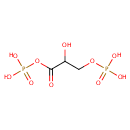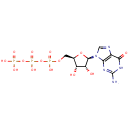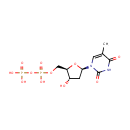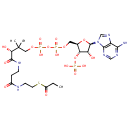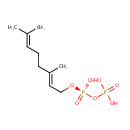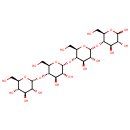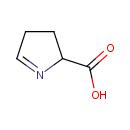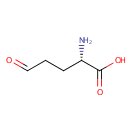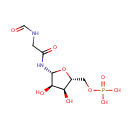
Search Results for compounds
Searching compounds for
returned 4373 results.
Glyceric acid 1,3-biphosphate (PAMDB000317)
IUPAC:
{[2-hydroxy-3-(phosphonooxy)propanoyl]oxy}phosphonic acid
CAS: 1981-49-3
Description: 1,3-Bisphosphogylcerate (1,3BPG), also known as PGAP, is a 3-carbon organic molecule present in most, if not all living creatures. It primarily exists as a metabolic intermediate in glycolysis during respiration.
Guanosine triphosphate (PAMDB000319)
IUPAC:
({[({[(2R,3S,4R,5R)-5-(2-amino-6-oxo-6,9-dihydro-1H-purin-9-yl)-3,4-dihydroxyoxolan-2-yl]methoxy}(hydroxy)phosphoryl)oxy](hydroxy)phosphoryl}oxy)phosphonic acid
CAS: 86-01-1
Description: Guanosine triphosphate (GTP) is a guanine nucleotide containing three phosphate groups esterified to the sugar moiety. GTP functions as a carrier of phosphates and pyrophosphates involved in channeling chemical energy into specific biosynthetic pathways. GTP activates the signal transducing G proteins which are involved in various cellular processes including proliferation, differentiation, and activation of several intracellular kinase cascades. Proliferation and apoptosis are regulated in part by the hydrolysis of GTP by small GTPases Ras and Rho. Another type of small GTPase, Rab, plays a role in the docking and fusion of vesicles and may also be involved in vesicle formation. In addition to its role in signal transduction, GTP also serves as an energy-rich precursor of mononucleotide units in the enzymatic biosynthesis of DNA and RNA.
dTDP (PAMDB000320)
IUPAC:
{[hydroxy({[(2R,3S,5R)-3-hydroxy-5-(5-methyl-2,4-dioxo-1,2,3,4-tetrahydropyrimidin-1-yl)oxolan-2-yl]methoxy})phosphoryl]oxy}phosphonic acid
CAS: 491-97-4
Description: dTDP is an intermediate in the synthesis and breakdown of DNA. Thymidylate kinase (EC 2.7.4.9; ATP:dTMP phosphotransferase) catalyzes the phosphorylation of dTMP (to form dTDP) in the dTTP synthesis pathway for DNA synthesis. (OMIM 188345
Propionyl-CoA (PAMDB000321)
IUPAC:
{[(2R,3S,4R,5R)-5-(6-amino-9H-purin-9-yl)-4-hydroxy-2-({[hydroxy({hydroxy[(3R)-3-hydroxy-2,2-dimethyl-3-[(2-{[2-(propanoylsulfanyl)ethyl]carbamoyl}ethyl)carbamoyl]propoxy]phosphoryl}oxy)phosphoryl]oxy}methyl)oxolan-3-yl]oxy}phosphonic acid
CAS: 317-66-8
Description: Propionyl-CoA is an intermediate in the metabolism of propanoate. Propionyl-CoA is a substrate for acetyl-CoA synthetase, propionyl-CoA synthetase and 2-methylcitrate synthase. It is also involved in beta-alanine metabolism, Valine, leucine abd isoleucine degradation and C5-branched dibasic acid metabolism pathways.
Geranyl-PP (PAMDB000324)
IUPAC:
[({[(2E)-3,7-dimethylocta-2,6-dien-1-yl]oxy}(hydroxy)phosphoryl)oxy]phosphonic acid
CAS: 763-10-0
Description: Geranyl diphosphate is regarded as a key intermediate in the steroid, isoprene and terpene biosynthesis pathways and is used by organisms in the biosynthesis of farnesyl pyrophosphate, geranylgeranyl pyrophosphate, cholesterol, terpenes and terpenoids. (wikipedia). In E.coli, geranyl diphosphate synthase (GPPS) catalyzes the condensation of dimethylallyl diphosphate (DMAPP) and isopentenyl diphosphate (IPP) to form geranyl diphosphate. Geranyl pyrophosphate is an intermediate in the HMG-CoA reductase pathway used by organisms in the biosynthesis of terpenes and terpenoids. (Wikipedia)
Maltotetraose (PAMDB000327)
IUPAC:
(2R,3R,4S,5S,6R)-2-{[(2R,3S,4R,5R,6R)-6-{[(2R,3S,4R,5R,6R)-4,5-dihydroxy-2-(hydroxymethyl)-6-{[(2R,3S,4R,5R)-4,5,6-trihydroxy-2-(hydroxymethyl)oxan-3-yl]oxy}oxan-3-yl]oxy}-4,5-dihydroxy-2-(hydroxymethyl)oxan-3-yl]oxy}-6-(hydroxymethyl)oxane-3,4,5-triol
CAS: 34612-38-9
Description: Maltotetraose is a member of the chemical class known as Tetrahexoses. These are tetrasaccharides containing four hexose carbohydrates. Maltotetraose is invovled in Glycerol degradation. r 15;80(8):2939-48.)
L-D-1-Pyrroline-5-carboxylic acid (PAMDB000329)
IUPAC:
3,4-dihydro-2H-pyrrole-2-carboxylic acid
CAS: 2906-39-0
Description: (S)-1-Pyrroline-5-carboxylate Pyrroline 5-carboxylate is an enamine or an imino acid that forms on spontaneous dehydration of L-glutamate γ-semialdehyde in aqueous solutions. The stereoisomer (S)-1-Pyrroline-5-carboxylate is an intermediate in glutamate metabolism, in arginine degradation and in proline biosynthesis and degradation and it can be converted to or be formed from the three amino acids L-glutamate, L-ornithine and L-proline. In particular, it is synthesized with the oxidation of proline by pyrroline-5-carboxylate reductase 1 (EC 1.5.1.2, PYCR1) or by proline dehydrogenase (EC 1.5.99.8, PRODH) and it is hydrolyzed to L-glutamate by delta-1-pyrroline-5-carboxylate dehydrogenase (EC 1.5.1.12, ALDH4A1). It is also one of the few metabolites that can be a precursor to other metabolites of both the urea cycle and the tricarboxylic acid (TCA) cycle.
Zinc (PAMDB000330)
IUPAC:
zinc(2+) ion
CAS: 7440-66-6
Description: Zinc is an essential element, necessary for sustaining all life. It is an essential trace element, necessary for plants, animals, and microorganisms. Zinc is found in nearly 100 specific enzymes (other sources say 300), serves as structural ions in transcription factors and is stored and transferred in metallothioneins. It is "typically the second most abundant transition metal in organisms" after iron and it is the only metal which appears in all enzyme classes. (Wikipedia)
L-Glutamic-gamma-semialdehyde (PAMDB000331)
IUPAC:
(2S)-2-amino-5-oxopentanoic acid
CAS: 496-92-4
Description: Glutamic gamma-semialdehyde is the metabolic precursor for proline biosynthesis. The conversion from L-Glutamate, an ATP- and NADPH-dependent reaction, is catalyzed by the enzyme Delta-1-pyrroline-5-carboxylate synthetase (P5CS) (OMIM 138250). L-Glutamic-gamma-semialdehyde can also be converted to or be formed from the amino acids L-ornithine (EC 2.6.1.13) and L-proline (EC 1.5.99.8 and EC 1.5.1.2). It is also one of the few metabolites that can be a precursor to other metabolites of both the urea cycle and the citric acid cycle (BioCyc)
5'-Phosphoribosyl-N-formylglycineamide (PAMDB000332)
IUPAC:
{[(2R,3S,4R,5R)-3,4-dihydroxy-5-(2-formamidoacetamido)oxolan-2-yl]methoxy}phosphonic acid
CAS: Not Available
Description: 5'-Phosphoribosyl-N-formylglycineamide (also known as FGAR or N-Formyl-GAR) is a substrate for Phosphoribosylformylglycinamidine synthase. It is involved in aminoimidazole ribonucleotide biosynthesis and plays a vital role in purine metabolism as well as the conversion of glutamine to glutamate. 5'-Phosphoribosyl-N-formylglycineamide is described as a glycinamide ribonucleotide having a phosphate group at the 5-position and a formyl group on the glycine nitrogen.
